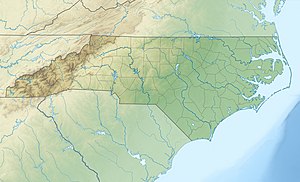Eagle Swamp
Appearance
| Eagle Swamp Tributary to Contentnea Creek | |
|---|---|
| Location | |
| Country | United States |
| State | North Carolina |
| County | Lenoir |
| Physical characteristics | |
| Source | Wheat Swamp divide |
| • location | pond at Hugo, North Carolina |
| • coordinates | 35°23′26″N 077°31′52″W / 35.39056°N 77.53111°W[1] |
| • elevation | 22 ft (6.7 m)[2] |
| Mouth | Contentnea Creek |
• location | Tick Bite, North Carolina |
• coordinates | 35°21′05″N 077°25′37″W / 35.35139°N 77.42694°W[1] |
• elevation | 1 ft (0.30 m)[2] |
| Length | 7.38 mi (11.88 km)[3] |
| Basin size | 10.07 square miles (26.1 km2)[4] |
| Discharge | |
| • location | Contentnea Creek |
| • average | 12.07 cu ft/s (0.342 m3/s) at mouth with Contentnea Creek[4] |
| Basin features | |
| Progression | Contentnea Creek → Neuse River → Pamlico Sound → Atlantic Ocean |
| River system | Neuse River |
| Tributaries | |
| • left | unnamed tributaries |
| • right | unnamed tributaries |
| Bridges | Sharon Church Road, Skeeter Pond Road, NC 11, S Highland Avenue, Tick Bite Road |
Eagle Swamp is a 7.38 mi (11.88 km) long 3rd order tributary to Contentnea Creek in Lenoir County, North Carolina.
Course[edit]
Eagle Swamp rises in Hugo, North Carolina and then flows southeast to join Contentnea Creek at Tick Bite.[2]
Watershed[edit]
Eagle Swamp drains 10.07 square miles (26.1 km2) of area, receives about 49.9 in/year of precipitation, has a wetness index of 595.43, and is about 15% forested.[4]
References[edit]
- ^ a b "GNIS Detail - Eagle Swamp". geonames.usgs.gov. US Geological Survey. Retrieved 6 October 2020.
- ^ a b c "Eagle Swamp Topo Map in Lenoir". TopoZone. Locality, LLC. Retrieved 6 October 2020.
- ^ "ArcGIS Web Application". epa.maps.arcgis.com. US EPA. Retrieved 6 October 2020.
- ^ a b c "Eagle Swamp Watershed Report". US EPA Geoviewer. US EPA. Retrieved 6 October 2020.


